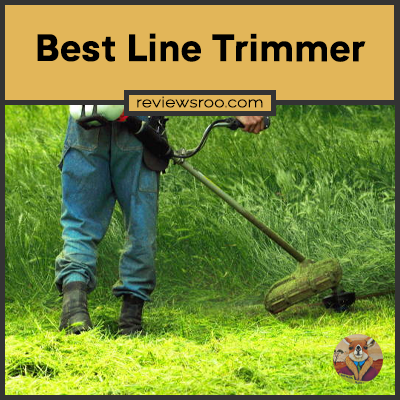Best Line Trimmer
Trimming the lawn is like taming a wild beast – it’s tedious and time-consuming, but in the end, you can take pride in your work. But with a good line trimmer, you can have a great looking lawn without spending all day on it. With so many different models to choose from, how do you know which one is best? In this article, we’ll explore the top line trimmers on the market and help you choose the one that suits your needs.

The grass may be greener on the other side of the fence, but if yours looks better than your neighbor’s it’s probably because of your line trimmer. A good line trimmer will make quick work of even the toughest weeds and overgrown grass. It’ll also let you get into tight spaces where regular mowers can’t reach. And with a variety of attachments available, you can use your trimmer for more than just trimming.
No matter what kind of job you have in mind for your line trimmer – whether it’s edging around flower beds or cutting back tall grass – there’s a model to fit your needs. We’ll look at some of the best and most popular choices so that you can make an informed decision about which one is right for you.
What To Look For When Buying A Line Trimmer
Choosing a line trimmer is like finding a needle in a haystack. With all the different options available, it can be hard to know what’s right for you. To make your decision easier, consider these factors: power source, cutting width, weight, noise level and cost.
Power source is an important factor in choosing a line trimmer. Electric models are typically cheaper with less power but are easier to maintain and quieter than gas-powered trimmers. Gas trimmers offer more power but require more maintenance and create more noise.
After determining the power source that best suits your needs, look at the cutting width of the model you choose; wider cutting widths cover larger areas faster but also weigh more. Additionally, consider the weight of the model – heavier trimmers are difficult to maneuver but can handle tougher jobs. Finally, pay attention to noise levels; some models may be louder than others when running and can be bothersome to neighbors or yourself if you’re using it for personal use. With these factors in mind, you’re well on your way to picking out the perfect line trimmer for your needs.
Types Of Line Trimmers
Line trimmers are popular tools used to trim and shape grass, hedges, and other garden features. In fact, over 90 million line trimmers are sold annually worldwide. There are different types of line trimmers to suit various needs.
Gas-powered trimmers offer more power than electric ones but require regular maintenance. They can be heavy and noisy, but their long reach makes them ideal for clearing large areas quickly. Cordless electric models offer portability, low noise levels, and require less maintenance than gas-powered models. They may not be as powerful or have the same range as gas-powered versions, however they’re still effective for small gardens with minimal obstacles. Manual push lawn mowers don’t require any fuel or electricity but are only suitable for small lawns with flat surfaces.
Whichever type you choose make sure it’s the right one for your needs. The next step is understanding line trimmer safety before operating any kind of line trimmer.
Understanding Line Trimmer Safety
Have you ever wondered how to use line trimmers safely? With the right safety precautions, you can keep yourself and your property safe while trimming. Here are three important things to keep in mind:
- Understanding the dangers of line trimmers:
- Wear protective gear: Make sure to wear safety glasses, gloves, long pants and closed-toe shoes while using a line trimmer.
- Be aware of your surroundings: Be careful around objects that could be thrown by the trimmer’s string. Also, watch out for low branches or other obstacles that could cause you to trip.
- Follow instructions: Read over the manual before using your line trimmer to make sure you understand how it works and what safety procedures should be followed.
- Proper maintenance of line trimmers:
- Change the spark plug regularly: It is important to replace the spark plug often so it doesn’t get worn out or clogged up with debris.
- Clean the air filter often: Cleaning the air filter will help ensure that your engine is running smoothly and efficiently.
- Check for loose parts: Regularly check all parts of your trimmer for signs of wear or tear, such as missing screws or broken strings.
- Operating a line trimmer safely:
- Keep hands away from blades: Make sure to keep your hands away from blades while they are spinning in order to avoid any accidents.
- Start slowly when trimming edges: When trimming edges, start slowly and gradually increase speed until you have reached a comfortable level.
- Shut down properly when done: After finishing up with trimming, make sure always shut down properly by following the instructions in your manual.
By following these tips, you can use a line trimmer safely and effectively for all of your yard work needs. Next up we’ll look at how to choose the right one for your yard!
Choosing The Right Line Trimmer For Your Yard
Shopping for a line trimmer can be overwhelming. It’s like finding the right pair of shoes: You want to find something that fits your needs, but also looks and feels good.
When it comes to choosing the right line trimmer for your yard, there are several factors to consider. First, think about how often you will use the trimmer and what kind of terrain you’ll be cutting. Chances are, if you’re an occasional user or have only small areas to trim around, a cordless electric model is probably the best choice. They’re lightweight, quiet, and easy to maneuver around tight spaces. However, if you need more power and reach, then a gas-powered model may be better suited for your needs.
Once you’ve narrowed down the type of line trimmer that’s right for you, take some time to compare features like cutting widths and noise levels between different models in your price range. This will help ensure that you get the most out of your purchase and that it meets all of your trimming requirements.
With these tips in mind, you’ll soon find yourself with a line trimmer that fits both your budget and needs perfectly – one that offers years of reliable performance with minimal maintenance required. Now it’s time to look into accessories to consider when buying a line trimmer; from blades and edgers to safety protective gear, there are plenty of options available so don’t forget to explore them all.
Accessories To Consider When Buying A Line Trimmer
What a coincidence! You already know the right line trimmer for your yard, and now you need to consider what accessories come with it. From edgers to extra spools of line, there are plenty of options to choose from when it comes to purchasing a line trimmer.
The most important accessory is the edger attachment. This makes it easy to get those hard-to-reach places like along fence lines or around garden beds. It also helps you keep your lawn looking neat and tidy by giving it a professional edge. An additional spool of trimmer line is also useful so that you can quickly swap out the empty one when needed without having to stop and reload. Additional safety equipment such as goggles, gloves and ear protection are also recommended for added safety during use.
By considering these accessories when buying a line trimmer, you’ll be able to get more out of your purchase and make sure that your yard looks its best all year round. Now let’s look at some tips for maintaining your line trimmer…
Tips For Maintaining A Line Trimmer
Keeping a line trimmer in prime condition is becoming increasingly important. According to the American Garden Tool Association, over 80 million Americans own some type of gardening tool. That’s a lot of trimmers that need maintenance! Here are 6 tips for maintaining your line trimmer.
First, keep your trimmer clean and free of debris. Regularly wiping it down with a damp cloth will help keep it looking great and prevent rusting. Second, store your trimmer away from direct sunlight when not in use. This will protect the engine from damage over time. Third, regularly check to make sure the blades are sharp and properly aligned. If they aren’t, take it to a professional for repair or replacement. Fourth, lubricate the moving parts before each use and after each cleaning session with a light oil like WD-40. Fifth, replace any damaged parts as soon as possible to prevent further damage or injury. Finally, always empty the fuel tank when you’re done using the trimmer so gas doesn’t sit inside for too long and cause corrosion or clogs.
Taking care of your line trimmer can extend its life and ensure you get the most out of it for years to come. And that’s not all – there are plenty of other benefits associated with owning one!
Benefits Of Line Trimmers
Line trimmers offer a multitude of benefits for anyone looking to cut grass, weeds, and brush. They are lightweight, relatively easy to use, and pack quite a punch when it comes to trimming power. The primary benefit of line trimmers is that they can reach tight spaces that mowers cannot. This makes them ideal for cutting around fences and other obstacles in the yard.
Line trimmers also provide an even cut, so users don’t have to worry about uneven patches of grass or weeds being left behind after mowing. Plus, they’re extremely maneuverable and can be used on slopes and in other difficult terrain without sacrificing performance. All these advantages combine to make line trimmers an excellent choice for any homeowner who wants the job done right without breaking the bank.
Transitioning into different models available, there’s something out there for everyone’s needs and budget.
Pros And Cons Of Different Line Trimmer Models
When it comes to line trimmers, there are many models to choose from. Each has their own pros and cons, so it’s important to consider the features of each before making a purchase. Here are some points to consider:
- Weight – Is the line trimmer heavy or lightweight?
- Power source – Is the power source electric, gas, or battery operated?
- Cutting head – Are there multiple cutting heads available and how easy is it to switch between them?
- Price – What is your budget for a line trimmer?
Once you have considered these points, you can decide which type of line trimmer best suits your needs. A lightweight electric model may be ideal for smaller yards while a gas-powered model may be best suited for larger spaces that require more power and torque. Consider all the features carefully and make sure you get one that meets your needs in terms of size, weight, power sources and cutting head options.
Whichever model you choose, make sure you read reviews and do some research first to ensure you get a quality product that will last for years to come. With the right line trimmer in hand, you can easily maintain your lawn or garden with ease. Transitioning into the next section, let’s take a look at common problems with line trimmers that may arise over time.
Common Problems With Line Trimmers
Like a gossamer web, line trimmers can often present homeowners with unexpected hiccups. Weaving in and out of the garden, these tools are run by electricity or gas and come with a host of common problems.
The most common issue is string tangling or breaking. This is when the line gets stuck in the spool and won’t come out. To avoid this, it’s important to not overfill the spool and to always use fresh string that hasn’t been used before. Other issues include overheating caused by running the device for too long at once, as well as fuel-related issues if using a gas-powered model.
Fortunately, many of these issues can be prevented or resolved with proper maintenance and care. Regularly checking for any wear and tear on the device itself, such as frayed strings or loose parts, is key to keeping your trimmer running safely and smoothly throughout its lifespan. With a bit of extra effort, you’ll be able to keep your garden looking neat without any trouble.
The Best Line Trimmers On The Market
The line trimmer is the tractor of a gardener’s toolbox – it takes care of heavy lifting and hard work. It’s like an extra pair of hands when you need to get the job done quickly, efficiently and with as little effort as possible. But just like with any other piece of equipment, there are good ones and bad ones on the market. So how do you know which line trimmer is the best for your needs?
It’s not easy to make a choice, but if you want to find the right one, you must take into account your needs and budget. Many people think that all line trimmers are the same but this isn’t true. Different models have different features, such as adjustable handlebars or different types of blades, so it’s important to compare options before making a purchase. Additionally, some models come with additional attachments or accessories that can increase its usability even further.
When looking for the best line trimmer, consider your garden size and type of terrain. If you have a large garden with lots of hills and uneven ground then you will need something more powerful than a standard model – perhaps one with a longer cutting swath or higher motor power. On the other hand, if you only have small areas to trim then something lighter and more compact may be better suited for you. Ultimately, it’s up to you to decide which model is best for your situation; take your time in researching and be sure to read reviews from previous customers before making any decisions!
Frequently Asked Questions
What Type Of Line Should Be Used For A Line Trimmer?
Irony has it that the best line trimmer may not always be the most expensive one. Does it really matter which type of line is used?
The answer is yes – different trimmers require different types of line. In a nutshell, corded electric trimmers use round plastic line, while battery-powered electric trimmers and cordless models use either round or square cut lines made from nylon or plastic. Gas-powered trimmers need heavier-duty lines like metal blades or serrated blades. So regardless of type, each trimmer requires its own special kind of line for optimal performance.
It pays to read the instructions on your particular model before you buy new line for your trimmer. Matching up the right kind of line with your machine will ensure a job well done without having to worry about overworking the engine or undercutting your lawn. Knowing what type of line works best will save time and money in the long run.
How Long Can A Line Trimmer Be Used For?
Surprisingly, there is no definite answer to how long a line trimmer can be used for. While it largely depends on the environment and conditions that the trimmer is being used in, as well as the type of line being used, its typical lifespan can range from anywhere between several months up to a couple of years.
It is important to take into account the various factors that could affect how long a line trimmer will last. For instance, if you use it frequently on harder surfaces such as concrete, its life expectancy may be shorter than when using it in softer terrain like grass or soil. The type of line also plays a role; thicker lines tend to last longer than thinner ones. Make sure you check your trimmer regularly and replace any worn-out parts so you can get the most out of your tool.
Is It Necessary To Wear Protective Equipment When Using A Line Trimmer?
Wearing protective equipment when using a line trimmer is essential. Safety glasses, long pants and sleeves, boots, and gloves should always be worn. This can help protect your eyes, skin and feet from flying debris that the trimmer produces.
It’s important to remember that when using any power tool safety should come first. Not wearing the proper protective gear can result in serious injuries or even death. So it’s best to err on the side of caution and put the safety gear on before operating the trimmer. That way you can be sure you’re taking all necessary precautions for your own wellbeing.
What Is The Best Way To Store A Line Trimmer When Not In Use?
A staggering 90% of line trimmers fail to last more than 3 years due to improper storage and maintenance. Storing a line trimmer is essential for its longevity. Here is the best way to store one when not in use:
- Clean the trimmer thoroughly before storing it. Remove any debris from the blades, body, and motor.
- Put away all the accessories and parts that came with the trimmer such as extra spools of line, oil, screws and bolts etc.
- After cleaning, lubricate all parts of the machine with oil or grease if applicable.
- Finally, stow away your trimmer in a dry place with plenty of air circulation where it won’t be exposed to extreme temperatures or humidity levels.
Storing your trimmer this way will help extend its life and ensure it’s ready to go when you need it most! The key is regular maintenance, like cleaning off dirt and debris after each use, so that it doesn’t corrode or rust over time. Taking a few simple steps now can save you time and money down the road. It pays to take care of your equipment!
How Often Should The Line Be Changed On A Line Trimmer?
The line trimmer is a popular tool for maintaining lawns and gardens. But how often should the line be changed? It’s a crucial question for anyone looking to get the most out of their trimmer.
Maintaining the line on your trimmer can be a tricky business, one that requires precision and skill. A dull line can cause damage to your lawn or garden and may even put you at risk of injury. On the other hand, changing it too soon can quickly add up in costs. So, what’s the right balance?
It depends on several factors, including the size and type of your trimmer and how hard you’re pushing it. Generally speaking, though, it’s best to change the line when it’s no longer cutting effectively. If you’re pulling too hard or noticing fraying or breakage on regular basis, it might be time for a new line. Regular inspections can help you spot these signs before they become an issue. And if in doubt, always replace sooner rather than later – better safe than sorry!
Conclusion
I know my line trimmer is a trusty companion when it comes to keeping my lawn neat and tidy. It’s like a loyal steed, always ready to take me on the next task.
It’s important to use the right type of line in order to get the most out of your trimmer. A good quality line will last longer and provide better results. It’s also important to wear protective clothing and equipment when using the trimmer – safety should never be overlooked.
In order to keep my line trimmer running like a well-oiled machine, I make sure that I store it correctly and replace the line regularly. That way, I can enjoy its performance for years to come, just like an old friend who stands by me no matter what.





